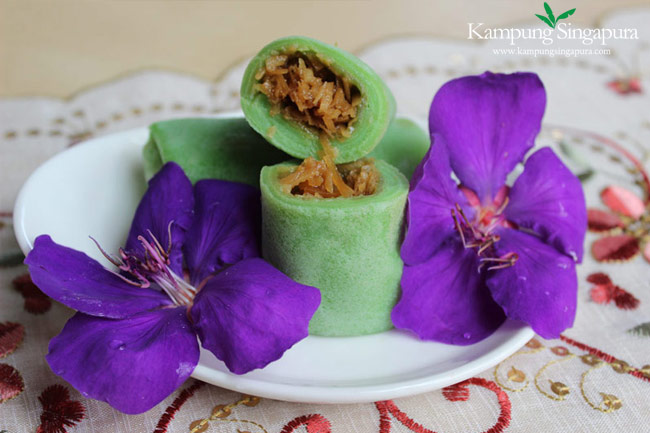
View Recipe Details Below
‘Kuih Dadar‘ is a traditional Peranakan delicacy. Before I go further to elaborate on the delicacy, let me give you a brief insight of the Singaporean Peranakan community. The Peranakans are descendants from 15th and 16th century immigrants who came to the Indonesian archipelago and British Malaya (Present Malaysia and Singapore) for trading purposes. Most of them chose to stay behind and married the locals. In the process, they adopted the respective local cultures and started living like them. It is often misconstrued that there are only Hoklo Chinese-Malay Peranakans. However, smaller communities of other types of Peranakans do exist as well. We have the Chitty Peranakans who are Indian Hindus, Jawi Peranakans who are Muslims from Pakistan and Kristang Peranakans who are Portuguese all of whom settled with the local Malays and adopted their language, customs and culture. A large majority of these Peranakans speak creole dialects (e.g. mixture of Malay and Hokkien for the Chinese Peranakans). A Peranakan woman is known as ‘Nonya’ and the man as ‘Baba’. (Source: Wikipedia and The Peranakan Association of Singapore)
Although small in number, the Peranakan’s traditional delicacies remain to this day as Singapore’s national delicacies. ‘Kuih Dadar’ is one such delicacy. ‘Kuih’ is a Malay word and it refers to sweet delicacy similar to the Western concept of cakes and pastries. ‘Kuih Dadar‘ is rolled pandan flavoured crepe filled with dessicated coconut steeped in palm sugar syrup. It is a sinful delight but one that Hasan and I devour so much. I have tried following many recipes but this simple one by wokkingmum is one that works for me. Easy to make and just melts in the mouth! I have adapted the recipe slightly to my preference. ![]()
Kuih Dadar

Ingredients:
- For Pandan Juice
- Pandan Leaves (Screwpine leaves) - 6
- Water - Little just to blend the pandan leaves
- For Crepe Batter
- Sifted Plain Flour - 100 gm
- Egg - 1 beaten well
- Pandan Juice - 1 tbsp or more if you like a greener hue
- Water - 150 ml
- For Filling
- Dessicated/ Grated coconut - 2 cups
- Gula Melaka (Palm Sugar) - 100 gm
- Water - 200 ml
Instructions:
To make the Pandan Juice
- Cut the pandan leaves into small pieces, place in a blender, add a little bit of water and blend finely
- Strain the juice using a small sieve. Retain only the juice.
For the Crepe Batter
- Mix all the ingredients together to form a smooth batter. Let it rest for a while.
For the Filling
- Boil the gula melaka with water on moderate heat till you get a thick syrup of two thread consistency.
- Add the dessicated coconut and mix well till the mixture is fairly dry.
To make the complete Kuih Dadar:
- Heat a small sized non-stick saucepan (the one that you would use normally to make pancakes) and add a teaspoon of oil.
- Ladle 2 tablespoons of batter and swirl it around the pan ensuring the base is covered fully.
- Remove the crepe the moment you see the colour changing, place it on a dry surface.
- Add 1 heaped teaspoon of the gula melaka coconut filling to the crepe, level it evenly and roll the crepe as you would with a spring roll.
- Repeat the process with the rest of the batter/filling.
- Kuih Dadar ready to be served =)
Tips
- With the crepe, some recipes call for you to cook it on both sides. An advice given to me by a close family friend who is a super chef with over 50 years of experience is that the right way is to cook it on one side and the moment the colour changes, it is an indication that the batter is cooked. Hence, no need to overcook it. When we overcook it, we will get the unwanted browning on the crepe.
- Another advice which she gave is to make sure both the crepe and filling are warm at the time of folding. The juiciness from the warm filling and the fresh, warm crepe will be tastier than a dried one anytime.



